Synthesis of Chiral Acyclic Pyrimidine Nucleoside Analogues from DHAP-Dependent Aldolases
Abstract
1. Introduction
2. Materials and Methods
2.1. Enzymes and Reagents
2.2. Instrumental
2.3. Substrate Synthesis
2.3.1. Aldehydes
2.3.2. Dihydroxyacetone Phosphate
2.4. Synthesis of Acyclic Nucleoside Analogues
2.5. 1H and 13C NMR Product Data
2.6. ESI-MS Experiments
2.7. Molecular Docking
3. Results
3.1. 5-(1-Thyminyl)-3,4-dihydroxy-2-oxopentyl Phosphate and 5-(1-Cytosyl)-3,4-dihydroxy-2-oxopentyl Phosphate Synthesis using RAMA as a Biocatalyst
3.2. 5-(1-Thyminyl)-3,4-dihydroxy-2-oxopentyl Phosphate and 5-(1-Cytosyl)-3,4-dihydroxy-2-oxopentyl Phosphatesynthesis Using TmRhu-1PA as a Biocatalyst
3.3. 5-(1-Thyminyl)-3,4-dihydroxy-2-oxopentyl Phosphate and 5-(1-Cytosyl)-3,4-dihydroxy-2-oxopentyl Phosphate Synthesis Using EcFuc-1PA as a Biocatalyst
3.4. Molecular Docking
4. Conclusions
Supplementary Materials
Author Contributions
Funding
Institutional Review Board Statement
Informed Consent Statement
Data Availability Statement
Acknowledgments
Conflicts of Interest
References
- Geraghty, R.J.; Aliota, M.T.; Bonnac, L.F. Broad-Spectrum Antiviral Strategies and Nucleoside Analogues. Viruses 2021, 13, 667. [Google Scholar] [CrossRef] [PubMed]
- Mirza, A.Z. Advancement in the Development of Heterocyclic Nucleosides for the Treatment of Cancer—A Review. Nucleosides Nucleotides Nucleic Acids 2019, 38, 836–857. [Google Scholar] [CrossRef]
- De Clercq, E.; Li, G. Approved Antiviral Drugs over the Past 50 Years. Clin. Microbiol. Rev. 2016, 29, 695–747. [Google Scholar] [CrossRef]
- Eriksson, U.; Peterson, L.W.; Kashemirov, B.A.; Hilfinger, J.M.; Drach, J.C.; Borysko, K.Z.; Breitenbach, J.M.; Kim, J.S.; Mitchell, S.; Kijek, P.; et al. Serine Peptide Phosphoester Prodrugs of Cyclic Cidofovir: Synthesis, Transport, and Antiviral Activity. Mol. Pharm. 2008, 5, 598–609. [Google Scholar] [CrossRef]
- Gómez-Coca, R.B.; Blindauer, C.A.; Sigel, A.; Operschall, B.P.; Holý, A.; Sigel, H. Extent of Intramolecular π-Stacks in Aqueous Solution in Mixed-Ligand Copper(II) Complexes Formed by Heteroaromatic Amines and Several 2-Aminopurine Derivatives of the Antivirally Active Nucleotide Analog 9-[2-(Phosphonomethoxy) Ethyl]Adenine (PMEA). Chem. Biodivers. 2012, 9, 2008–2034. [Google Scholar] [CrossRef]
- De Clercq, E.; Holý, A. Case History: Acyclic Nucleoside Phosphonates: A Key Class of Antiviral Drugs. Nat. Rev. Drug Discov. 2005, 4, 928–940. [Google Scholar] [CrossRef]
- Holy, A.; Jaroslav, G.; Dvorakova, H.; De Clercq, E. Structure−Antiviral Activity Relationship in the Series of Pyrimidine and Purine N-[2-(2-Phosphonomethoxy)ethyl] Nucleotide Analogues. 1. Derivatives Substituted at the Carbon Atoms of the Base. J. Med. Chem. 1999, 42, 2064–2086. [Google Scholar] [CrossRef]
- Heathcote, E.J.; Marcellin, P.; Buti, M.; Gane, E.; De Man, R.A.; Krastev, Z.; Germanidis, G.; Lee, S.S.; Flisiak, R.; Kaita, K.; et al. Three-Year Efficacy and Safety of Tenofovir Disoproxil Fumarate Treatment for Chronic Hepatitis B. Gastroenterology 2011, 140, 132–143. [Google Scholar] [CrossRef]
- Garg, H.; Sarin, S.K.; Kumar, M.; Garg, V.; Sharma, B.C.; Kumar, A. Tenofovir Improves the Outcome in Patients with Spontaneous Reactivation of Hepatitis B Presenting as Acute-on-Chronic Liver Failure. Hepatology 2011, 53, 774–780. [Google Scholar] [CrossRef]
- Luo, M.; Groaz, E.; Andrei, G.; Snoeck, R.; Kalkeri, R.; Ptak, R.G.; Hartman, T.; Buckheit, R.W.; Schols, D.; De Jonghe, S.; et al. Expanding the Antiviral Spectrum of 3-Fluoro-2-(Phosphonomethoxy)Propyl Acyclic Nucleoside Phosphonates: Diamyl Aspartate Amidate Prodrugs. J. Med. Chem. 2017, 60, 6220–6238. [Google Scholar] [CrossRef]
- Xie, M.S.; Niu, H.Y.; Qu, G.R.; Guo, H.M. The Development for the Synthesis of Chiral Acyclic Nucleosides and Their Phosphonates. Tetrahedron Lett. 2014, 55, 7156–7166. [Google Scholar] [CrossRef]
- Liang, L.; Xie, M.S.; Qin, T.; Zhu, M.; Qu, G.R.; Guo, H.M. Regio- and Enantioselective Synthesis of Chiral Pyrimidine Acyclic Nucleosides via Rhodium-Catalyzed Asymmetric Allylation of Pyrimidines. Org. Lett. 2017, 19, 5212–5215. [Google Scholar] [CrossRef]
- Zhang, Q.; Ma, B.W.; Wang, Q.Q.; Wang, X.X.; Hu, X.; Xie, M.S.; Qu, G.R.; Guo, H.M. The Synthesis of Tenofovir and Its Analogues via Asymmetric Transfer Hydrogenation. Org. Lett. 2014, 16, 2014–2017. [Google Scholar] [CrossRef]
- Pomeisl, K.; Lamatová, N.; Šolínová, V.; Pohl, R.; Brabcová, J.; Kašička, V.; Krečmerová, M. Enantioselective Resolution of Side-Chain Modified Gem-Difluorinated Alcohols Catalysed by Candida Antarctica Lipase B and Monitored by Capillary Electrophoresis. Bioorganic Med. Chem. 2019, 27, 1246–1253. [Google Scholar] [CrossRef] [PubMed]
- Kołodziejska, R.; Górecki, M.; Frelek, J.; Dramiński, M. Enantioselective Enzymatic Desymmetrization of the Prochiral Pyrimidine Acyclonucleoside. Tetrahedron Asymmetry 2012, 23, 683–689. [Google Scholar] [CrossRef]
- Lafuente, L.; Maidana, L.G.; Bisceglia, J.A.; Iribarren, A.M.; Lewkowicz, E.S. Organocatalytic Synthesis of Benzimidazole Derivatives. Synthesis 2022, 54, 5471–5478. [Google Scholar] [CrossRef]
- Palazzolo, M.A.; Nigro, M.J.; Iribarren, A.M.; Lewkowicz, E.S. A Chemoenzymatic Route to Prepare Acyclic Nucleoside Analogues. Eur. J. Org. Chem. 2016, 2016, 921–924. [Google Scholar] [CrossRef]
- Lee, S.H.; Yeom, S.J.; Kim, S.E.; Oh, D.K. Development of Aldolase-Based Catalysts for the Synthesis of Organic Chemicals. Trends Biotechnol. 2022, 40, 306–319. [Google Scholar] [CrossRef]
- Clapés, P.; Fessner, W.D.; Sprenger, G.A.; Samland, A.K. Recent Progress in Stereoselective Synthesis with Aldolases. Curr. Opin. Chem. Biol. 2010, 14, 154–167. [Google Scholar] [CrossRef]
- Dean, S.M.; Greenberg, W.A.; Wong, C.H. Recent Advances in Aldolase-Catalyzed Asymmetric Synthesis. Adv. Synth. Catal. 2007, 349, 1308–1320. [Google Scholar] [CrossRef]
- Gamenara, D. Biocatalyzed Carbon–Carbon Bond Formation in Enantioselective Synthesis. In Biocatalysis in Asymmetric Synthesis; Academic Press: Cambridge, MA, USA, 2024; pp. 237–296. [Google Scholar] [CrossRef]
- Galkin, A.; Li, Z.; Li, L.; Kulakova, L.; Pal, L.R.; Dunaway-Mariano, D.; Herzberg, O. Structural Insights into the Substrate Binding and Stereoselectivity of Giardia Fructose-1,6-Bisphosphate Aldolase. Biochemistry 2009, 48, 3186–3196. [Google Scholar] [CrossRef] [PubMed]
- Hélaine, V.; Gastaldi, C.; Lemaire, M.; Clapés, P.; Guérard-Hélaine, C. Recent Advances in the Substrate Selectivity of Aldolases. ACS Catal. 2022, 12, 733–761. [Google Scholar] [CrossRef]
- Dai, Y.; Zhang, J.; Jiang, B.; Zhang, T.; Chen, J. New Strategy for Rare Sugars Biosynthesis: Aldol Reactions Using Dihydroxyacetone Phosphate (DHAP)-Dependent Aldolases. Food Biosci. 2021, 44, 101377. [Google Scholar] [CrossRef]
- Yang, J.; Zhu, Y.; Li, J.; Men, Y.; Sun, Y.; Ma, Y. Biosynthesis of Rare Ketoses through Constructing a Recombination Pathway in an Engineered Corynebacterium Glutamicum. Biotechnol. Bioeng. 2015, 112, 168–180. [Google Scholar] [CrossRef] [PubMed]
- Espelt, L.; Parella, T.; Bujons, J.; Solans, C.; Joglar, J.; Delgado, A.; Clapés, P. Stereoselective Aldol Additions Catalyzed by Dihydroxyacetone Phosphate-Dependent Aldolases in Emulsion Systems: Preparation and Structural Characterization of Linear and Cyclic Iminopolyols from Aminoaldehydes. Chem.-A Eur. J. 2003, 9, 4887–4899. [Google Scholar] [CrossRef] [PubMed]
- Concia, A.L.; Gómez, L.; Parella, T.; Joglar, J.; Clapés, P. Casuarine Stereoisomers from Achiral Substrates: Chemoenzymatic Synthesis and Inhibitory Properties. J. Org. Chem. 2014, 79, 5386–5389. [Google Scholar] [CrossRef] [PubMed]
- Bednarski, M.D.; Simon, E.S.; Bischofberger, N.; Fessner, W.D.; Kim, M.J.; Lees, W.; Saito, T.; Waldmann, H.; Whitesides, G.M. Rabbit Muscle Aldolase as a Catalyst in Organic Synthesis. J. Am. Chem. Soc. 1989, 111, 627–635. [Google Scholar] [CrossRef]
- Gefflaut, T.; Blonski, C.; Perie, J.; Willson, M. Class I Aldolases: Substrate Specificity, Mechanism, Inhibitors and Structural Aspects. Prog. Biophys. Mol. Biol. 1995, 63, 301–340. [Google Scholar] [CrossRef] [PubMed]
- Schmidt, N.G.; Eger, E.; Kroutil, W. Building Bridges: Biocatalytic C-C-Bond Formation toward Multifunctional Products. ACS Catal. 2016, 6, 4286–4311. [Google Scholar] [CrossRef] [PubMed]
- Chênevert, R.; Lavoie, M.; Dasser, M. Use of Aldolases in the Shyntesis of Non-Carbohydrate Natural Products. Stereoselective Synthesis of Aspicilin C-3–C-9 Fragment. Can. J. Chem. 1997, 75, 68–73. [Google Scholar] [CrossRef]
- Duncan, R.; Drueckhammer, D.G. Preparation of Deoxy Sugars via Aldolase-Catalyzed Synthesis of 1-Deoxy-1-Thioketoses. J. Org. Chem. 1996, 61, 438–439. [Google Scholar] [CrossRef] [PubMed]
- Clapés, P.; Garrabou, X. Current Trends in Asymmetric Synthesis with Aldolases. Adv. Synth. Catal. 2011, 353, 2263–2283. [Google Scholar] [CrossRef]
- Fessner, W.-D.; Sinerius, G.; Schneider, A.; Dreyer, M.; Schulz, G.E.; Badia, J.; Aguilar, J. Diastereoselective Enzymatic Aldol Additions: L-Rhamnulose and L-Fuculose 1-Phosphate Aldolases from E. coli. Angew. Chem. Int. Ed. Engl. 1991, 30, 555–558. [Google Scholar] [CrossRef]
- Oroz-Guinea, I.; Hernández, K.; Campsbres, F.; Guérard-Hélaine, C.; Lemaire, M.; Clapés, P.; García-Junceda, E. L-Rhamnulose-1-Phosphate Aldolase from Thermotoga Maritima in Organic Synthesis: One-Pot Multistep Reactions for the Preparation of Imino- and Nitrocyclitols. Adv. Synth. Catal. 2015, 357, 1951–1960. [Google Scholar] [CrossRef]
- Li, Z.; Wu, X.; Cai, L.; Duan, S.; Liu, J.; Yuan, P.; Nakanishi, H.; Gao, X.D. Enzymatic Synthesis of Rare Sugars with L-Rhamnulose-1-Phosphate Aldolase from Thermotoga Maritima MSB8. Bioorganic Med. Chem. Lett. 2015, 25, 3980–3983. [Google Scholar] [CrossRef] [PubMed]
- Laurent, V.; Darii, E.; Aujon, A.; Debacker, M.; Petit, J.L.; Hélaine, V.; Liptaj, T.; Breza, M.; Mariage, A.; Nauton, L.; et al. Synthesis of Branched-Chain Sugars with a DHAP-Dependent Aldolase: Ketones Are Electrophile Substrates of Rhamnulose-1-Phosphate Aldolases. Angew. Chem.-Int. Ed. 2018, 57, 5467–5471. [Google Scholar] [CrossRef]
- Jeyakanthan, J.; Taka, J.; Kikuchi, A.; Kuroishi, C.; Yutani, K.; Shiro, Y. Purification, Crystallization and Preliminary X-Ray Crystallographic Study of the L-Fuculose-1-Phosphate Aldolase (FucA) from Thermus Thermophilus HB8. Acta Crystallogr. Sect. F Struct. Biol. Cryst. Commun. 2005, 61, 1075–1077. [Google Scholar] [CrossRef] [PubMed]
- Choi, I.G.; Cho, C.S.; Cho, Y.; Yu, Y.G. Overproduction, Purification, and Characterization of Heat Stable Aldolase from Methanococcus Jannaschii, a Hyperthermophic Archaea. J. Biochem. Mol. Biol. 1998, 31, 130–134. [Google Scholar]
- Jaafar, N.R.; Littler, D.; Beddoe, T.; Rossjohn, J.; Md Illias, R.; Mahadi, N.M.; Mackeen, M.M.; Murad, A.M.A.; Abu Bakar, F.D. Crystal Structure of Fuculose Aldolase from the Antarctic Psychrophilic Yeast Glaciozyma Antarctica PI12. Acta Crystallogr. Sect. F Struct. Biol. Commun. 2016, 72, 831–839. [Google Scholar] [CrossRef]
- Li, Z.; Cai, L.; Qi, Q.; Styslinger, T.J.; Zhao, G.; Wang, P.G. Synthesis of Rare Sugars with L-Fuculose-1-Phosphate Aldolase (FucA) from Thermus Thermophilus HB8. Bioorganic Med. Chem. Lett. 2011, 21, 5084–5087. [Google Scholar] [CrossRef]
- Bres, F.C.; Guérard-Hélaine, C.; Hélaine, V.; Fernandes, C.; Sánchez-Moreno, I.; Traïkia, M.; García-Junceda, E.; Lemaire, M. L-Rhamnulose-1-Phosphate and l-Fuculose-1-Phosphate Aldolase Mediated Multi-Enzyme Cascade Systems for Nitrocyclitol Synthesis. J. Mol. Catal. B Enzym 2015, 114, 50–57. [Google Scholar] [CrossRef]
- Laborda, P.; Sayago, F.J.; Cativiela, C.; Parella, T.; Joglar, J.; Clapés, P. Aldolase-Catalyzed Synthesis of Conformationally Constrained Iminocyclitols: Preparation of Polyhydroxylated Benzopyrrolizidines and Cyclohexapyrrolizidines. Org. Lett. 2014, 16, 1422–1425. [Google Scholar] [CrossRef] [PubMed]
- Schümperli, M.; Pellaux, R.; Panke, S. Chemical and Enzymatic Routes to Dihydroxyacetone Phosphate. Appl. Microbiol. Biotechnol. 2007, 75, 33–45. [Google Scholar] [CrossRef]
- Jung, S.H.; Jeong, J.H.; Miller, P.; Wong, C.H. An Efficient Multigram-Scale Preparation of Dihydroxyacetone Phosphate. J. Org. Chem. 1994, 59, 7182–7184. [Google Scholar] [CrossRef]
- Charmantray, F.; El Blidi, L.; Gefflaut, T.; Hecquet, L.; Bolte, J.; Lemaire, M. Improved Straightforward Chemical Synthesis of Dihydroxyacetone Phosphate through Enzymatic Desymmetrization of 2,2-Dimethoxypropane-1,3-Diol. J. Org. Chem. 2004, 69, 9310–9312. [Google Scholar] [CrossRef]
- Schoevaart, R.; Van Rantwijk, F.; Sheldon, R.A. A Four-Step Enzymatic Cascade for the One-Pot Synthesis of Non-Natural Carbohydrates from Glycerol. J. Org. Chem. 2000, 65, 6940–6943. [Google Scholar] [CrossRef]
- Charmantray, F.; Dellis, P.; Samreth, S.; Hecquet, L. An Efficient Chemoenzymatic Route to Dihydroxyacetone Phosphate from Glycidol for the In Situ Aldolase-Mediated Synthesis of Monosaccharides. Tetrahedron Lett. 2006, 47, 3261–3263. [Google Scholar] [CrossRef]
- Fessner, W.D.; Sinerius, G. Synthesis of Dihydroxyacetone Phosphate (and Isosteric Analogues) by Enzymatic Oxidation; Sugars from Glycerol. Angew. Chem. Int. Ed. Engl. 1994, 33, 209–211. [Google Scholar] [CrossRef]
- Van Herk, T.; Hartog, A.F.; Schoemaker, H.E.; Wever, R. Simple Enzymatic In Situ Generation of Dihydroxyacetone Phosphate and Its Use in a Cascade Reaction for the Production of Carbohydrates: Increased Efficiency by Phosphate Cycling. J. Org. Chem. 2006, 71, 6244–6247. [Google Scholar] [CrossRef]
- Wong, C.H.; Whitesides, G.M. Synthesis of Sugars by Aldolase-Catalyzed Condensation Reactions. J. Org. Chem. 1983, 48, 3199–3205. [Google Scholar] [CrossRef]
- Itoh, N.; Tujibata, Y.; Liu, J.Q. Cloning and Overexpression in Escherichia Coli of the Gene Encoding Dihydroxyacetone Kinase Isoenzyme I from Schizosaccharomyces Pombe, and Its Application to Dihydroxyacetone Phosphate Production. Appl. Microbiol. Biotechnol. 1999, 51, 193–200. [Google Scholar] [CrossRef] [PubMed]
- Sánchez-Moreno, I.; García-García, J.F.; Bastida, A.; García-Junceda, E. Multienzyme System for Dihydroxyacetone Phosphate-Dependent Aldolase Catalyzed C-C Bond Formation from Dihydroxyacetone. Chem. Commun. 2004, 4, 1634–1635. [Google Scholar] [CrossRef] [PubMed]
- Sánchez-Moreno, I.; Iturrate, L.; Martín-Hoyos, R.; Jimeno, M.L.; Mena, M.; Bastida, A.; García-Junceda, E. From Kinase to Cyclase: An Unusual Example of Catalytic Promiscuity Modulated by Metal Switching. ChemBioChem 2009, 10, 225–229. [Google Scholar] [CrossRef] [PubMed]
- Sánchez-Moreno, I.; Iturrate, L.; Doyagüez, A.E.G.; Martínez, J.A.; Fernández-Mayoralas, A.; García-Junceda, E. Activated Aβ-Unsaturated Aldehydes as Substrate of Dihydroxyacetone Phosphate (DHAP)-Dependent Aldolases in the Context of a Multienzyme System. Adv. Synth. Catal. 2009, 351, 2967–2975. [Google Scholar] [CrossRef] [PubMed]
- Oroz-Guinea, I.; Sánchez-Moreno, I.; Mena, M.; García-Junceda, E. Hyperthermophilic Aldolases as Biocatalyst for C–C Bond Formation: Rhamnulose 1-Phosphate Aldolase from Thermotoga Maritima. Appl. Microbiol. Biotechnol. 2015, 99, 3057–3068. [Google Scholar] [CrossRef] [PubMed]
- Iturrate, L.; García-Junceda, E. Multi-Step Enzyme. Biotransformations and Chemoenzymatic Synthesis; Wiley-VCH Verlag GMBH & Co. KGaA: Weinheim, Germany, 2008; pp. 61–81. [Google Scholar]
- Nigro, M.J.; Brardinelli, J.I.; Lewkowicz, E.S.; Iribarren, A.M.; Laurella, S.L. Aldehyde-Hydrate Equilibrium in Nucleobase 2-Oxoethyl Derivatives: An NMR, ESI-MS and Theoretical Study. J. Mol. Struct. 2017, 1144, 49–57. [Google Scholar] [CrossRef]
- Labute, P. Protonate3D: Assignment of Ionization States and Hydrogen Coordinates to Macromolecular Structures. Proteins Struct. Funct. Bioinform. 2009, 75, 187–205. [Google Scholar] [CrossRef]
- Rigual, A.J.; Cantero, J.; Risso, M.; Rodríguez, P.; Rodríguez, S.; Paulino, M.; Gamenara, D.; Veiga, N. New Mechanistic Insights into the Reversible Aldol Reaction Catalysed by Rhamnulose-1-Phosphate Aldolase from Escherichia Coli. Mol. Catal. 2020, 495, 111131. [Google Scholar] [CrossRef]
- Hypercube Inc. HyperChem, 8.0.10. Molecular Modeling System. Hypercube Inc.: Gainesville, FL, USA, 2002.
- Jones, G.; Willett, P.; Glen, R.C.; Leach, A.R.; Taylor, R. Development and Validation of a Genetic Algorithm for Flexible Docking. J. Mol. Biol. 1997, 267, 727–748. [Google Scholar] [CrossRef]
- Kroemer, M.; Schulz, G.E. The Structure of L-Rhamnulose-1-Phosphate Aldolase (Class II) Solved by Low-Resolution SIR Phasing and 20-Fold NCS Averaging. Acta Crystallogr. Sect. D Biol. Crystallogr. 2002, 58, 824–832. [Google Scholar] [CrossRef]
- Accelrys Software Inc. Discovery Studio Visualizer, v3.0; Accelrys Software Inc.: San Diego, CA, USA, 2009.
- Nigro, M.J.; Palazzolo, M.A.; Colasurdo, D.; Iribarren, A.M.; Lewkowicz, E.S. N-Acetylneuraminic Acid Aldolase-Catalyzed Synthesis of Acyclic Nucleoside Analogues Carrying a 4-Hydroxy-2-Oxoacid Moiety. Catal. Commun. 2019, 121, 73–77. [Google Scholar] [CrossRef]
- Iglesias, L.E.; Lewkowicz, E.S.; Medici, R.; Bianchi, P.; Iribarren, A.M. Biocatalytic Approaches Applied to the Synthesis of Nucleoside Prodrugs. Biotechnol. Adv. 2015, 33, 412–434. [Google Scholar] [CrossRef]
- Mitchell, T.N.; Costisella, B. NMR—From Spectra to Structures: An Experimental Approach; Springer: Berlin/Heidelberg, Germany, 2004; Volume 41, ISBN 9783540721956. [Google Scholar]
- Grimblat, N.; Gavín, J.A.; Hernández Daranas, A.; Sarotti, A.M. Combining the Power of J Coupling and DP4 Analysis on Stereochemical Assignments: The J-DP4 Methods. Org. Lett. 2019, 21, 4003–4007. [Google Scholar] [CrossRef]
- Marcarino, M.O.; Zanardi, M.M.; Cicetti, S.; Sarotti, A.M. NMR Calculations with Quantum Methods: Development of New Tools for Structural Elucidation and Beyond. Acc. Chem. Res. 2020, 53, 1922–1932. [Google Scholar] [CrossRef]
- Smith, S.G.; Goodman, J.M. Assigning Stereochemistry to Single Diastereoisomers by GIAO NMR Calculation: The DP4 Probability. J. Am. Chem. Soc. 2010, 132, 12946–12959. [Google Scholar] [CrossRef]
- Wolinski, K.; Hinton, J.F.; Pulay, P. Efficient Implementation of the Gauge-Independent Atomic Orbital Method for NMR Chemical Shift Calculations. J. Am. Chem. Soc. 1990, 112, 8251–8260. [Google Scholar] [CrossRef]
- Zanardi, M.M.; Sarotti, A.M. GIAO C-H COSY Simulations Merged with Artificial Neural Networks Pattern Recognition Analysis. Pushing the Structural Validation a Step Forward. J. Org. Chem. 2015, 80, 9371–9378. [Google Scholar] [CrossRef]
- Grimblat, N.; Zanardi, M.M.; Sarotti, A.M. Beyond DP4: An Improved Probability for the Stereochemical Assignment of Isomeric Compounds Using Quantum Chemical Calculations of NMR Shifts. J. Org. Chem. 2015, 80, 12526–12534. [Google Scholar] [CrossRef]
- Ardao, I.; Alvaro, G.; Benaiges, M.D. Reversible Immobilization of Rhamnulose-1-Phosphate Aldolase for Biocatalysis: Enzyme Loading Optimization and Aldol Addition Kinetic Modeling. Biochem. Eng. J. 2011, 56, 190–197. [Google Scholar] [CrossRef]
- Babich, L.; Hartog, A.F.; Van Hemert, L.J.C.; Rutjes, F.P.J.T.; Wever, R. Synthesis of Carbohydrates in a Continuous Flow Reactor by Immobilized Phosphatase and Aldolase. ChemSusChem 2012, 5, 2348–2353. [Google Scholar] [CrossRef]
- Joerger, A.C.; Mueller-Dieckmann, C.; Schulz, G.E. Structures of L-Fuculose-1-Phosphate Aldolase Mutants Outlining Motions during Catalysis. J. Mol. Biol. 2000, 303, 531–543. [Google Scholar] [CrossRef]
- Espelt, L.; Bujons, J.; Parella, T.; Calveras, J.; Joglar, J.; Delgado, A.; Clapés, P. Aldol Additions of Dihydroxyacetone Phosphate to N-Cbz-Amino Aldehydes Catalyzed by L-Fuculose-1-Phosphate Aldolase in Emulsion Systems: Inversion of Stereoselectivity as a Function of the Acceptor Aldehyde. Chem.-A Eur. J. 2005, 11, 1392–1401. [Google Scholar] [CrossRef]
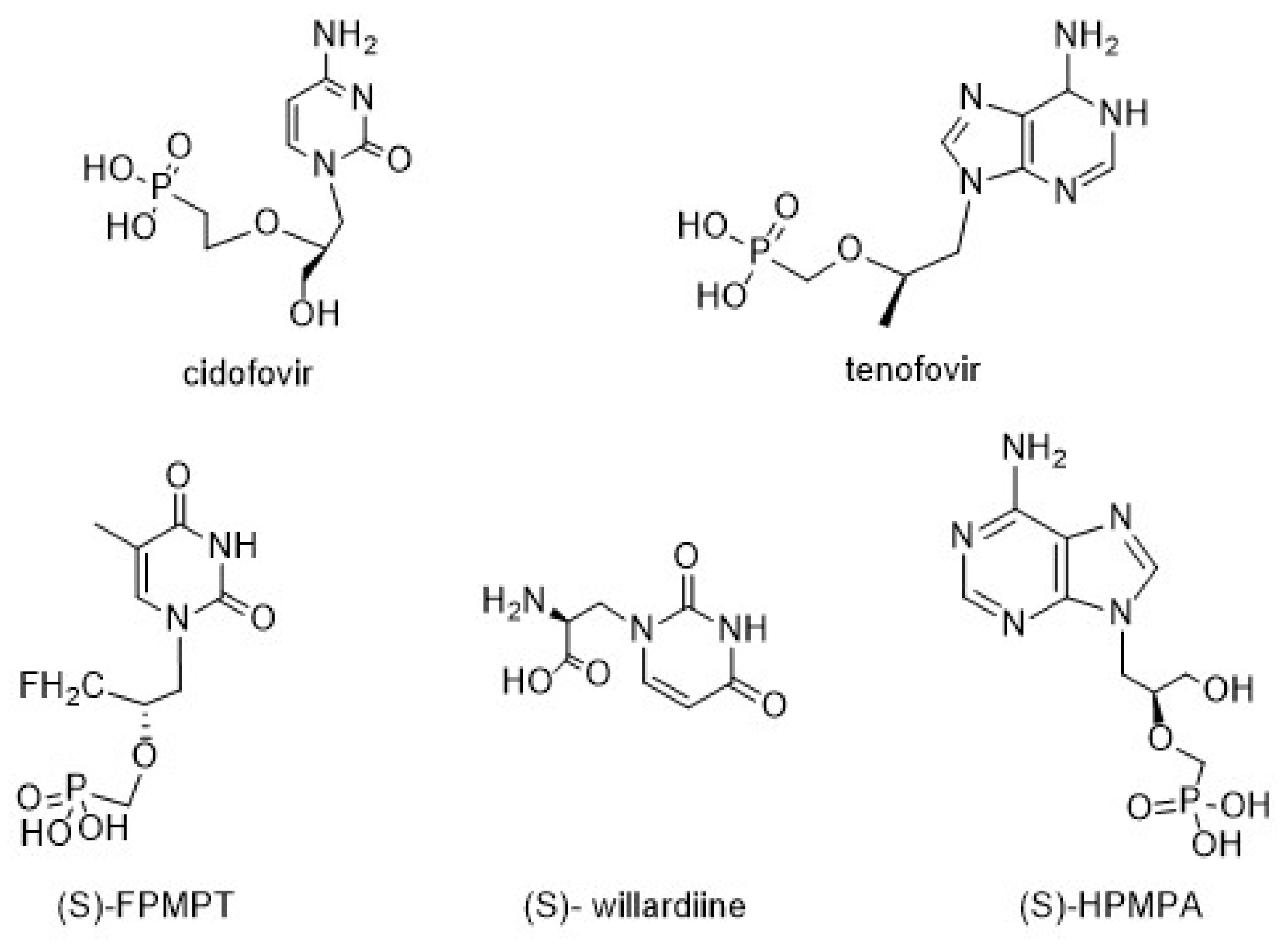
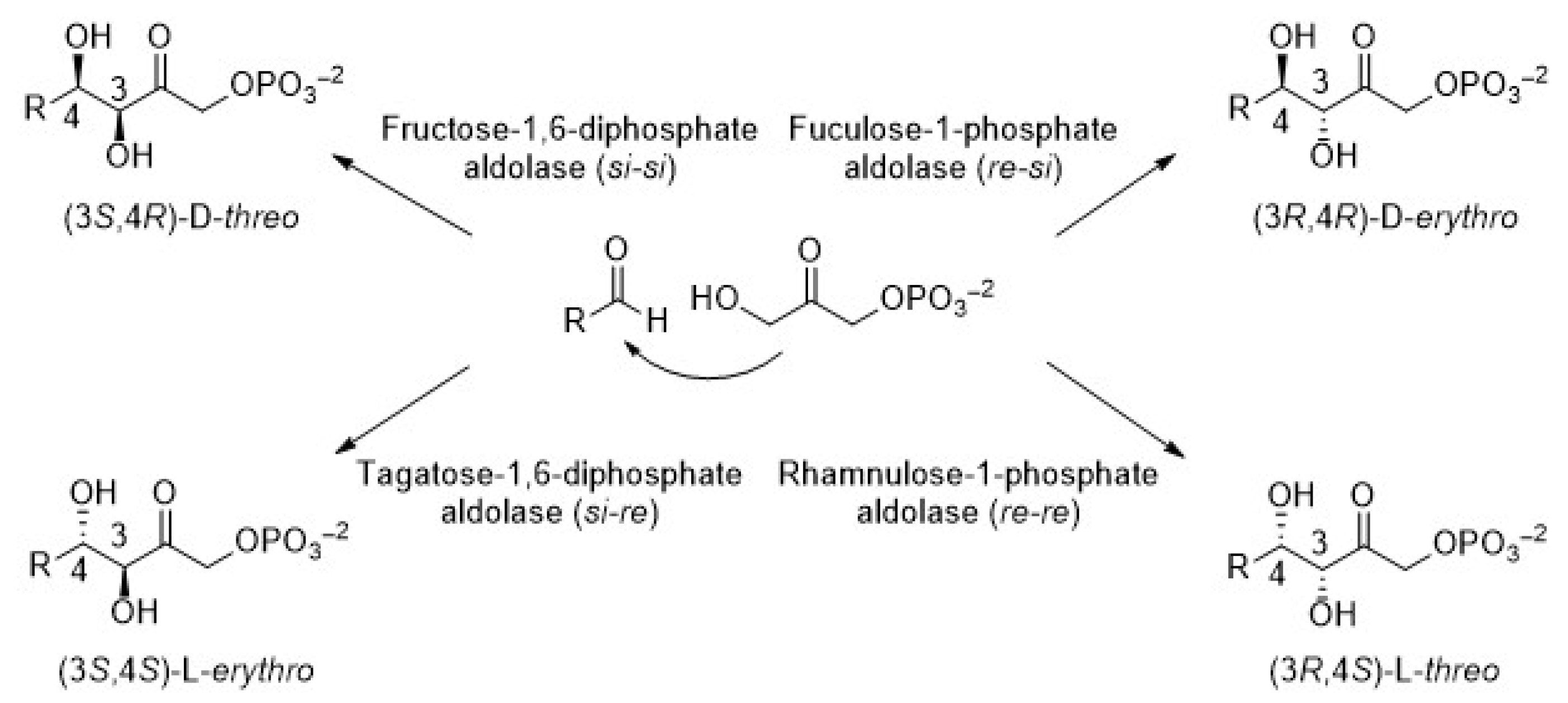

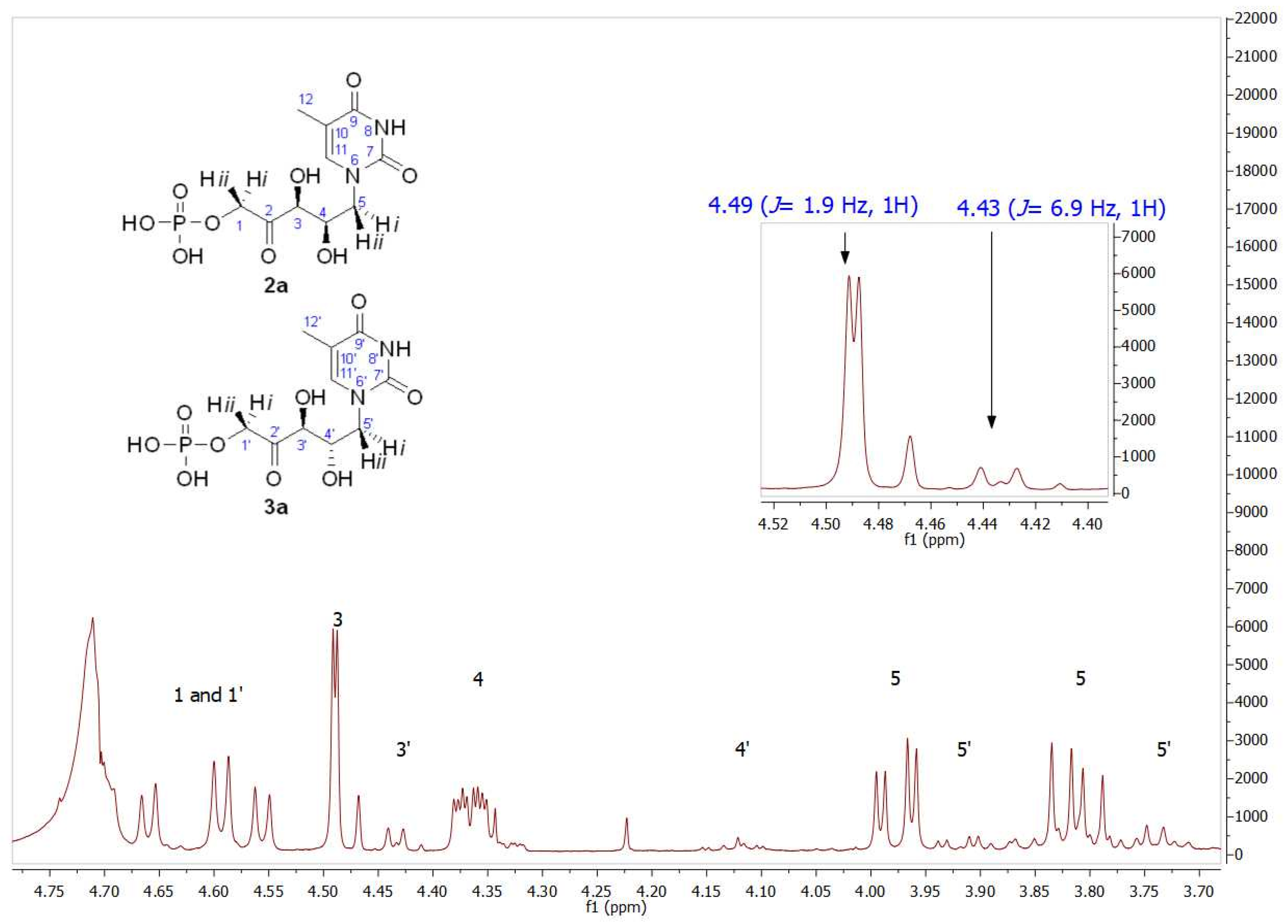

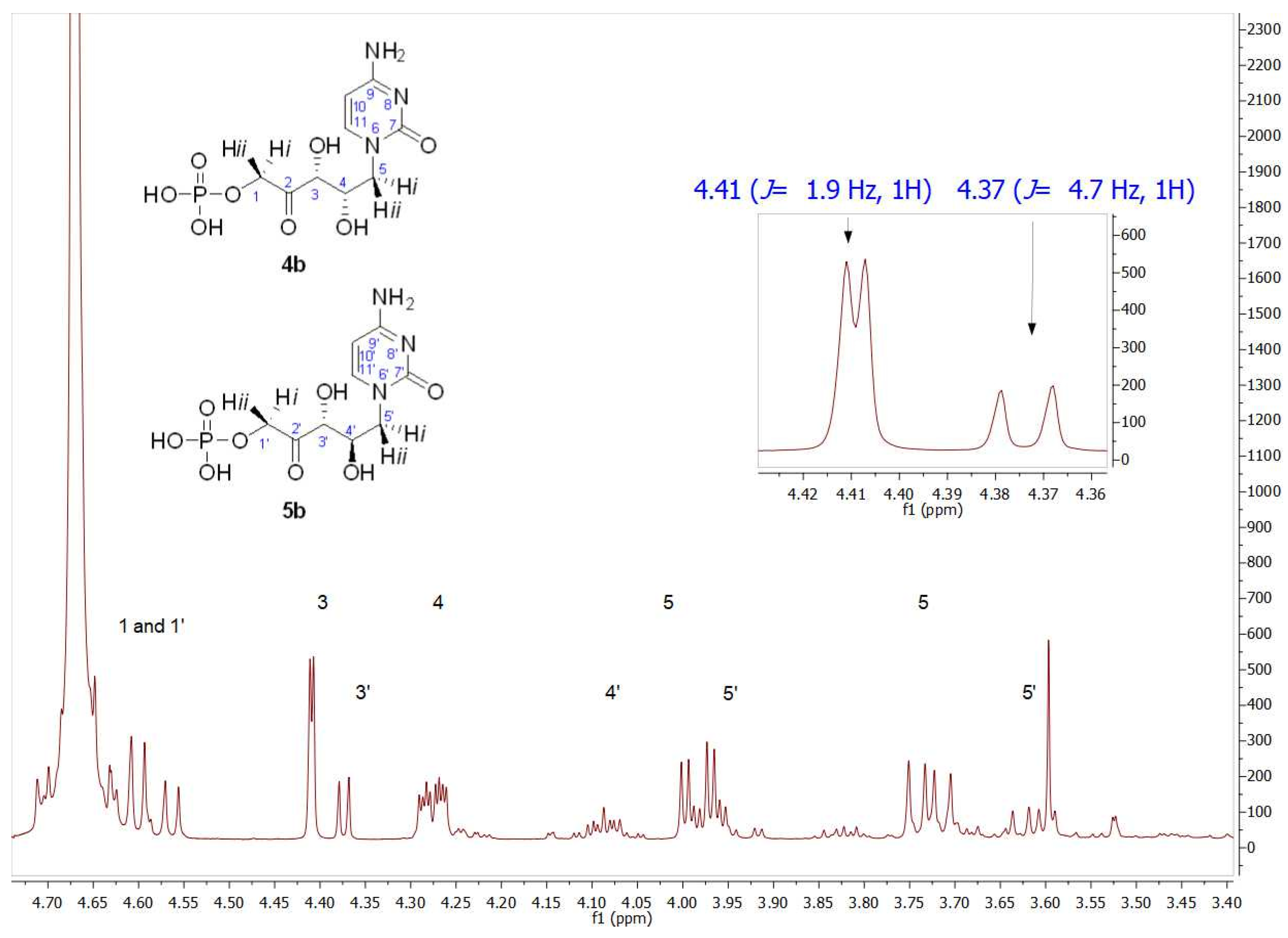



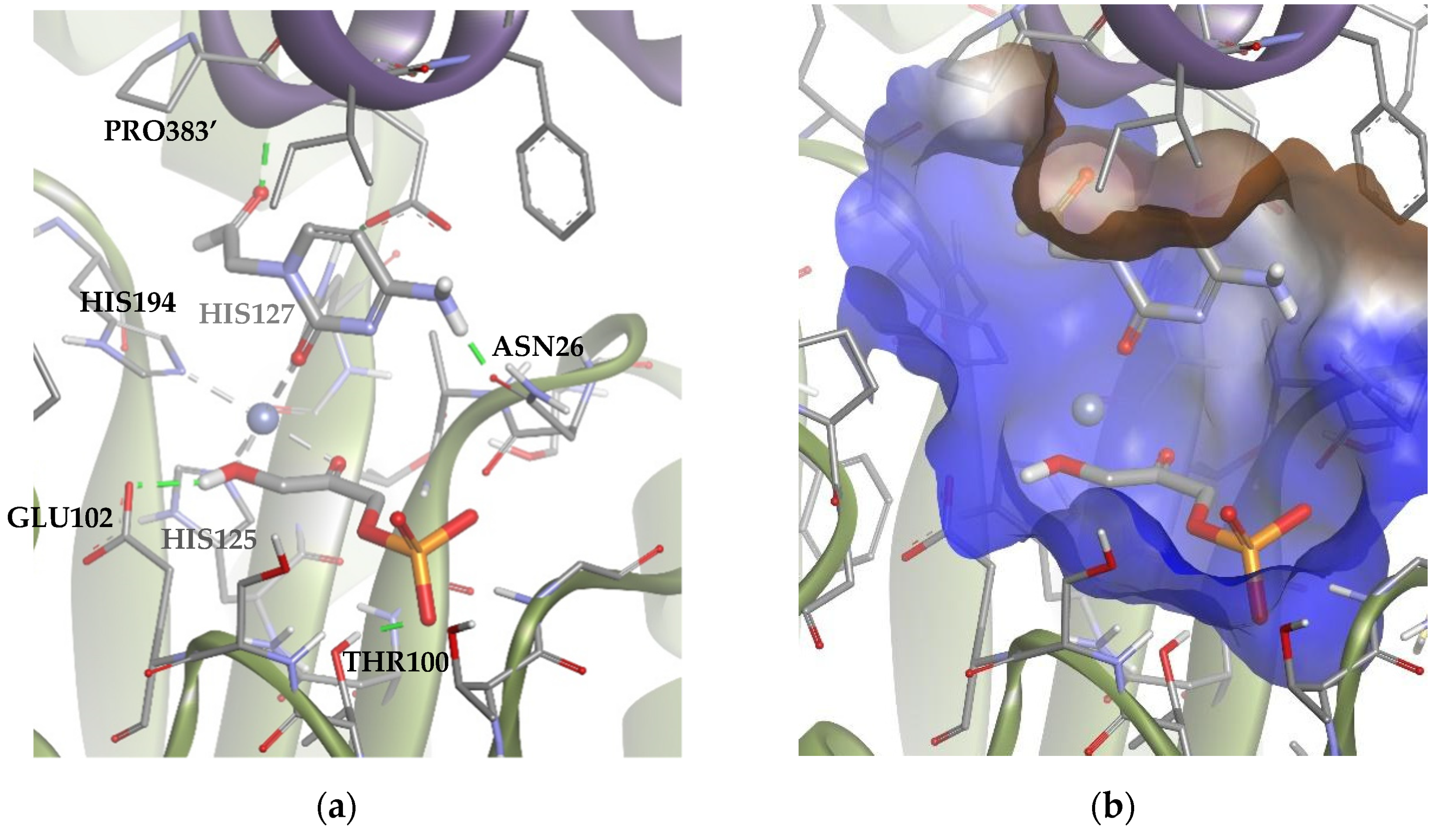
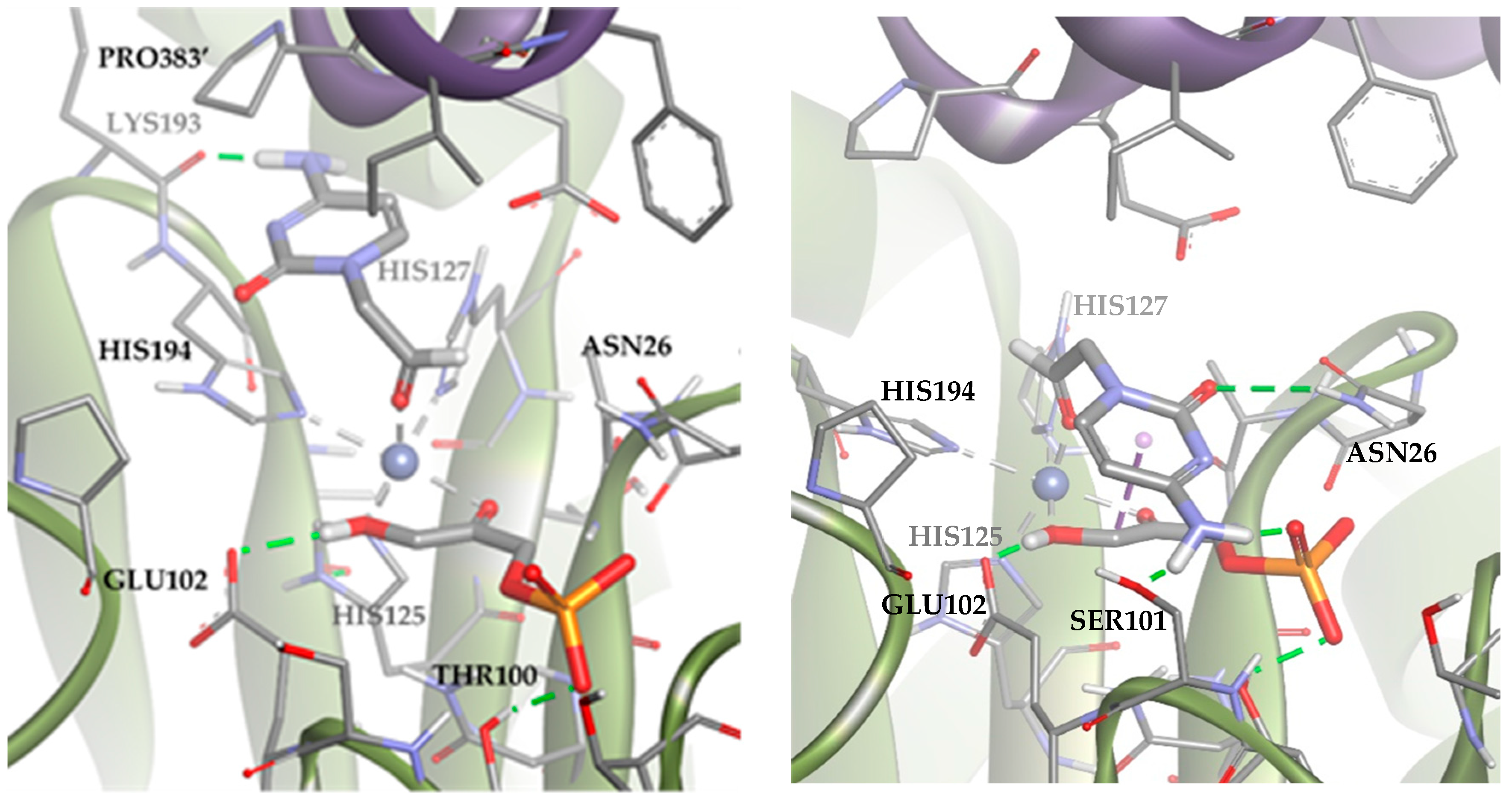
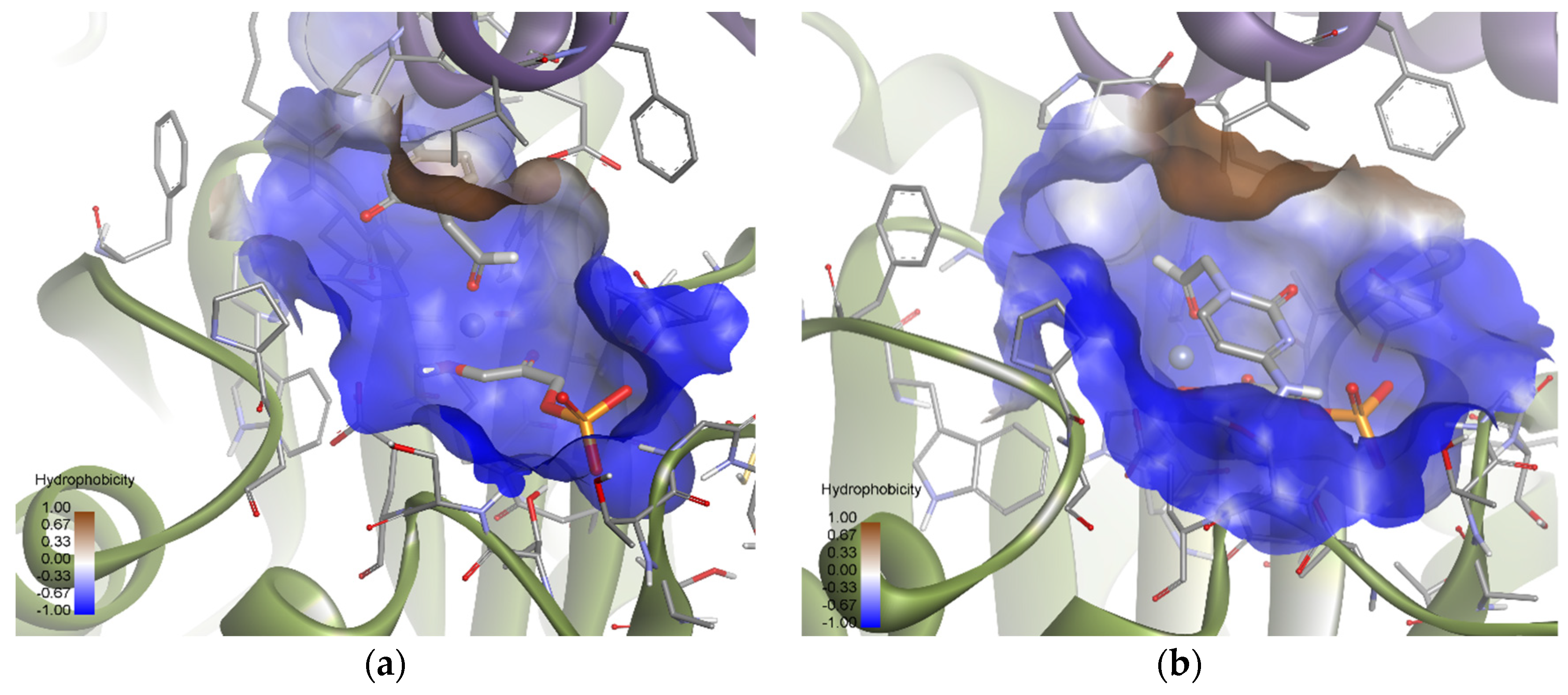
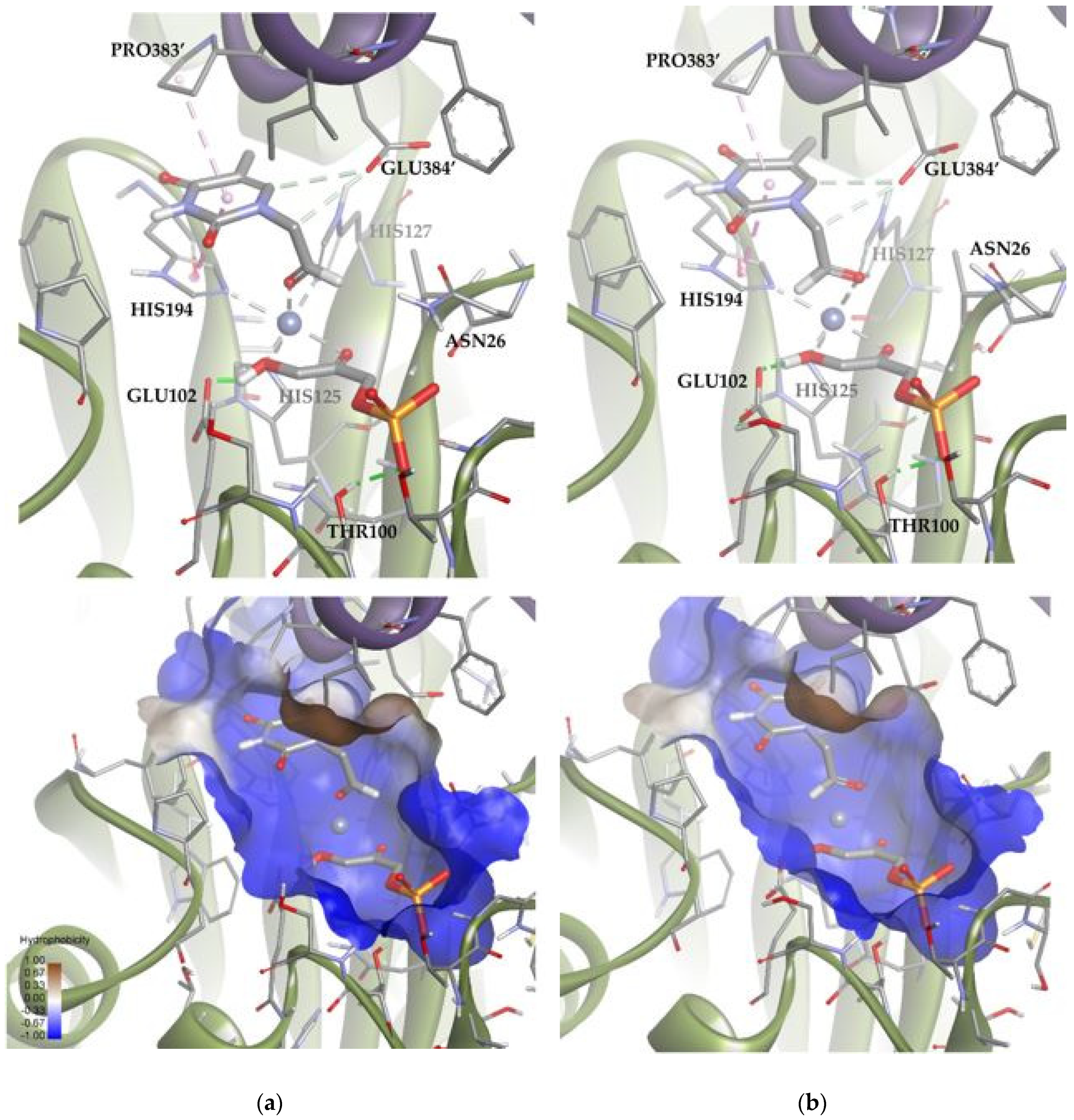
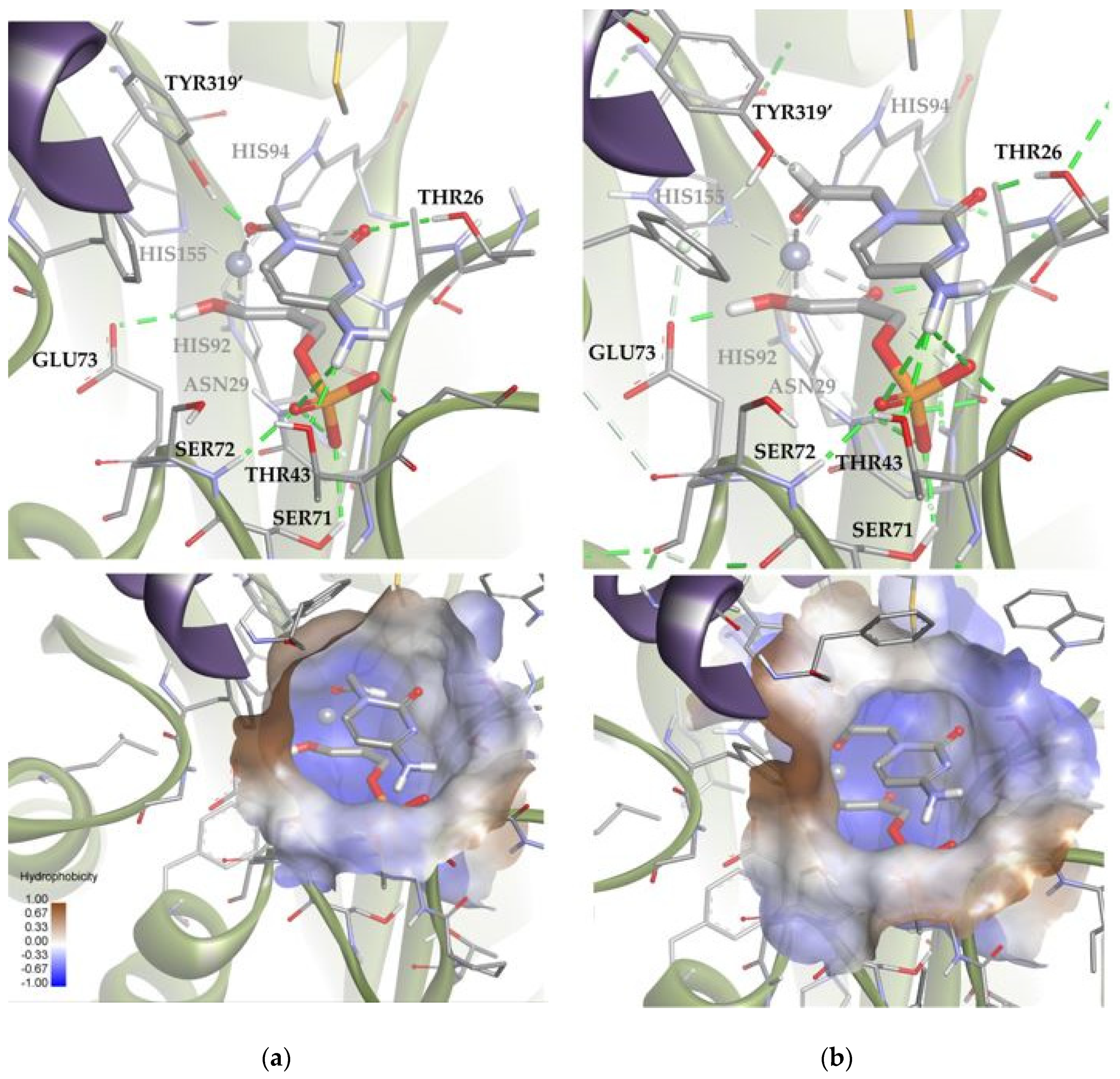

Disclaimer/Publisher’s Note: The statements, opinions and data contained in all publications are solely those of the individual author(s) and contributor(s) and not of MDPI and/or the editor(s). MDPI and/or the editor(s) disclaim responsibility for any injury to people or property resulting from any ideas, methods, instructions or products referred to in the content. |
© 2024 by the authors. Licensee MDPI, Basel, Switzerland. This article is an open access article distributed under the terms and conditions of the Creative Commons Attribution (CC BY) license (https://creativecommons.org/licenses/by/4.0/).
Share and Cite
Nigro, M.; Sánchez-Moreno, I.; Benito-Arenas, R.; Valino, A.L.; Iribarren, A.M.; Veiga, N.; García-Junceda, E.; Lewkowicz, E.S. Synthesis of Chiral Acyclic Pyrimidine Nucleoside Analogues from DHAP-Dependent Aldolases. Biomolecules 2024, 14, 750. https://doi.org/10.3390/biom14070750
Nigro M, Sánchez-Moreno I, Benito-Arenas R, Valino AL, Iribarren AM, Veiga N, García-Junceda E, Lewkowicz ES. Synthesis of Chiral Acyclic Pyrimidine Nucleoside Analogues from DHAP-Dependent Aldolases. Biomolecules. 2024; 14(7):750. https://doi.org/10.3390/biom14070750
Chicago/Turabian StyleNigro, Mariano, Israél Sánchez-Moreno, Raúl Benito-Arenas, Ana L. Valino, Adolfo M. Iribarren, Nicolás Veiga, Eduardo García-Junceda, and Elizabeth S. Lewkowicz. 2024. "Synthesis of Chiral Acyclic Pyrimidine Nucleoside Analogues from DHAP-Dependent Aldolases" Biomolecules 14, no. 7: 750. https://doi.org/10.3390/biom14070750
APA StyleNigro, M., Sánchez-Moreno, I., Benito-Arenas, R., Valino, A. L., Iribarren, A. M., Veiga, N., García-Junceda, E., & Lewkowicz, E. S. (2024). Synthesis of Chiral Acyclic Pyrimidine Nucleoside Analogues from DHAP-Dependent Aldolases. Biomolecules, 14(7), 750. https://doi.org/10.3390/biom14070750






